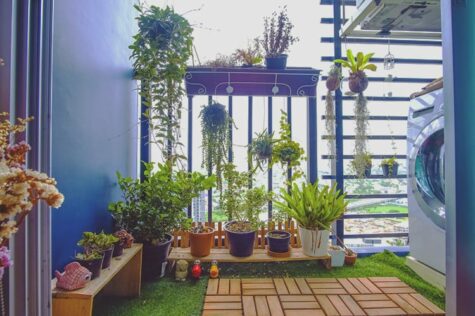The clematis plant offers gardeners over 200 varieties of colourful, pretty blooms which can climb a trellis, cover an ugly part of your garden and provide a splash of colour from late spring until autumn.
This climbing vine needs sunshine, rich soil and some support as it climbs. Read on to see how you can provide the best trellis for your clematis.

Credit: Shutterstock
There are 3 different types of clematis, defined by when they flower, which also decides when they need to be pruned.
- Group 1: These varieties bloom in spring after the frosts in April, May and early June.
- Group 2: Summer flowering types, these bloom repeatedly from July through to August.
- Group 3: Later blooming varieties provide flowers in August and September through to the frostier days in the autumn.
How to trellis clematis: 5 ideas to support your clematis flowers
Detailed pruning instructions can be found below but first, let’s look at the best trellis options for clematis in the UK.
1. Natural trellis for your clematis
If you have an ornamental flower bed and a useful tree, your clematis will be delighted to climb most trees, apart from a black walnut tree. This tree tends to inhibit the growth of almost anything.
This fabulous white clematis provides stunning views from all sides, the white contrasting against the crisp mown lawn or reaching for the skies, adding a natural line of ascending blooms to delight the eye.
This planting is so successful because the bloom is in the sunshine while the roots have a lot of cover from surrounding foliage. This is what clematis loves.
Remember to plan your garden design, keeping in mind all the views different angles offer. Here the green lawn contrasts perfectly with the crisp white flowers.
2. Wire fence
A wire fence is ideal for any dwarf clematis, which will grow beautifully along it. This gorgeous purple dwarf clematis grows happily along a wire fence and the height is perfect to display the colourful blooms to perfection.

Credit: Shutterstock
3. Trellis
A trellis can be purchased from any good gardening centre or you can build a trellis yourself.
Wooden varieties that you fix to your wall are ideal for clematis, which can be placed in a pot underneath. The best location is a site where the flowers are in solid sunshine most of the day but the roots are cool.

Credit: Shutterstock
You can add mulch to help with this. A specially designed support cage such as the GrowBox™ will provide support in the flowering months but once the clematis dies back, it can be conveniently packed away in storage for the winter months.
4. Individual bamboo poles
Bamboo poles or a tepee of stakes made from garden prunings is an excellent trellis for summer-blooming clematis varieties.

Credit: Shutterstock
Vegetable growers who plant runner beans usually build a trellis support for them. You can surprise visitors to your garden by having two types of flowers appear on your bean patch!
The clematis is probably best growing in its own pot, which can be planted in amongst the beans but free to attach it to the frame for support. This will work well for smaller clematis varieties, which can grow as high as 2-5 feet (61cm-1.5m). You can prune it back when the flowering period finishes.
5. Arbours and sheds
For the really tall types of clematis, an arbour provides good support although you can also use your garden shed or any unsightly areas you would prefer to decorate with flowers! The tallest clematis, like Jack-in-the-beanstalk, can reach a height from 8 to 12 feet (2.4 – 3.6 m).

Credit: Shutterstock
Caring for your clematis
How often do I need to water my clematis?
You need to water pot clematis fairly frequently, particularly if the weather is hot and dry. Watering in dry weather is a must. If you have mulched the roots, this will help to retain moisture too. Give it a thorough soaking and wet the whole root ball.
For clematis rooted in the ground, it is fine to water weekly or if the leaves and flowers look as if they are wilting.
What’s the best soil for clematis?
Give your clematis rich soil or it may disappoint you. Add a top layer of mulch in spring to feed the plant throughout the flowering season but also to retain moisture.
Clematis loves sunshine on its flowers but it appreciates cooler roots which the mulch provides. These are hungry plants – think of all the effort they put into climbing. So give them a sunny location with rich soil and they will reward you with abundant blooms.

Credit: Shutterstock
FAQs – Tina’s Tips
When does clematis flower?
It depends on the variety. There are 3 types of clematis – spring flowering, summer flowering and late flowering. So some clematis will be in bloom in May, while others wait until July and the late bloomers will continue well into the autumn. There are evergreen varieties, woody plants and a range of hybrid varieties.
Remember that the flowers only last brief periods, after which you need to remove the wilting flower. This is called dead-heading. For the dwarf varieties, you can ask your younger gardeners to take this on as a task. Normally they will be delighted to do this!
When do I plant clematis?
It is best to prepare the ground for planting clematis in the autumn if possible, which gives it plenty of time to get settled. However, you can plant in spring and some spring-planted clematis manage to flower that summer so don’t despair!
Although my advice is definitely to plant them in the ground if you can, clematis is certainly a plant that will not disappoint you simply because it is in a pot.
What can go wrong with my clematis?
- Pruning. It is really important to know when to prune. Refer back to the 3 types of clematis described earlier in this article. Know which variety you have. If you prune back your clematis that likes to flower on second-year growth, you will deprive yourself of flowers by pruning in the autumn. So check the label carefully! Read on for pruning instructions.
- Clematis wilt shows as black stems and the whole plant seems to collapse. Sterilise your secateurs and cut all the blackened stems off. Be sure to clean the blade between cuts, to prevent infection of the healthy leaves. Destroy all these stems and do not compost them. Your plant will have some unaffected growth so keep a close eye on it to spot any further symptoms.
- Powdery mildew is caused by congestion of stems with air unable to circulate. Tie in the stems to your trellis often and deadhead the blooms. Try to water the roots not the leaves if mildew is a problem.
- Pests. Aphids and red spider mites can be a problem. Try to encourage natural predators like ladybirds and you can mist the leaves down with water and a few drops of neem oil. Then wipe the leaves well to remove the pests. Red spider mites cannot survive on damp leaves so wipe them down weekly.
- Not enough sunshine, poor soil and lack of water will not allow much energy for flowers either so pray to the weather gods for sunshine, not rain!

Clematis flower wilt. Credit: Shutterstock
How should I prune my clematis?
With great care! Depending on when they flower, the pruning is different for each group.
Group 1: The spring-flowering clematis plants need to be pruned immediately after they finish blooming. For example, because new buds grow on the last season’s growth, early spring blooming varieties should be pruned back as soon as possible following their flowers.
Group 2: This group flower over and over and they can bloom on either new wood or old wood. These are the clematis with large flowers that burst into bloom late in spring. Prune back to the top buds either in winter or early in the spring.
Group 3: This group of clematis are late bloomers. They only flower on new wood so prune these hard to about 2 feet (60 cm or so) in the winter as a task for a cold day.

Save this pin for later








